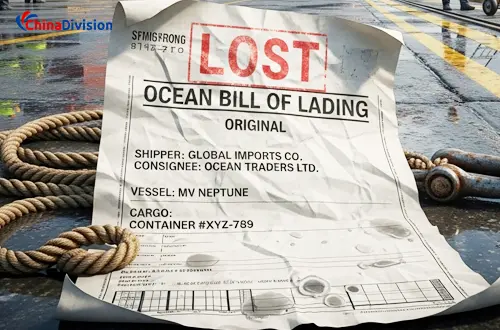How Can a Lost Ocean Bill of Lading Not Only Affect Customs Clearance?
As proof of title to the goods, the importance of the OBL (also known as the Original OBL) is self-evident. Losing an OBL means the OBL, the "proof of title" to the goods, is broken in the transportation chain—potentially leading to demurrage charges or, worse, the goods being misappropriated and disputes arising from title.
Table of Contents
- Emergency Reporting + Risk Control
- Achieving "B/L Pickup Without a Bill of Lading"
- Coordinate customs clearance and cargo collection to avoid port demurrage
- Risk Warning: Preventative Measures for Lost Bills of Lading
- Why is the Original Ocean Bill of Lading Important?
- Need a partner to help resolve lost bills of lading?
However, in the face of this emergency, simply following the three-step process of "emergency reporting → official reissue/replacement by telex release → customs clearance and cargo collection" can minimize losses and ensure smooth delivery of goods. As a professional international shipping service provider, Chinadivision will provide you with a detailed explanation of this emergency plan and offer comprehensive international logistics and transportation services.

Step 1: Emergency Reporting + Risk Control (Must do this within 24 hours of loss)
When a bill of lading (B/L) is lost, time is of the essence. You must immediately initiate a "reporting and freezing" action to prevent fraudulent use of the B/L to claim the goods and to secure evidence of the loss.
1. Immediately notify key parties and secure control of the goods.
Notify the freight forwarder/shipping company.
Submit a "B/L Loss Statement" to the booking freight forwarder or directly to the shipping company, specifying the B/L number, cargo information, time of loss, and reason (e.g., lost by courier, lost by employee, etc.). Request that the shipping company suspend the release and collection of the B/L. The shipping company's system can temporarily lock the B/L status to prevent fraudulent claims.
Notify the destination agent.
If the goods have arrived or are about to arrive, notify the shipping company's destination agent that the B/L has been lost and release is temporarily prohibited. This prevents the destination port from mistakenly releasing the goods to the B/L holder (if the B/L has already been transferred).
Notify the consignee.
Inform the consignee of the lost bill of lading and negotiate a later pickup time to avoid the consignee refusing to cooperate due to not receiving the bill of lading. Also, discuss in advance the necessary documents for subsequent pickup.
Note: You must provide a copy of your company's business license and a copy of the ID card of the person handling the matter (with the official seal) to verify the legitimacy of the reporting entity.
2. Retain evidence of loss to support reissue.
Lost by courier:
If the bill of lading is lost during courier delivery, request a "Certificate of Loss" from the courier company (specifying the tracking number, shipping/receiving information, and confirmation of loss). Keep the courier label and shipping records.
Internal loss:
If the loss occurs within the company, a "Statement of Loss of the Bill of Lading" (with the official seal) must be provided, detailing the circumstances of the loss, the responsible party, and the preventive measures. Some shipping companies require this document for reissue review.
Step 2: Achieving "B/L Pickup Without a Bill of Lading"
If a bill of lading is lost, you can't directly replace the original (because it's unique and prevents duplicate pickup). However, you can either "replace" the bill of lading with a telex release or reissue the original bill of lading. Chinadivision recommends prioritizing the telex release option (which is faster and less expensive).
1. Telex Release Bill of Lading Replacement (Recommended, can be completed within 1-3 days)
If the consignee agrees to a telex release bill of lading, you can skip the reissue process and directly apply for a telex release replacement. This is particularly useful for short-sea routes or emergency situations where the cargo has already arrived at the port.
Submitting a Telex Release Application
Submit a "Telex Release Application Form" to the freight forwarder/shipping company (both the shipper and consignee must confirm and stamp the application, clearly stating "Due to the loss of the bill of lading, request for telex release of the original bill of lading").
Paying the Telex Release Fee
Shipping companies typically charge a telex release fee of US$50-200 per shipment, and some freight forwarders may add a service fee. After payment, receive a "Telex Release Confirmation." Transmitting the Telex Release Certificate
The shipping company will send a telex release order to the destination agent and provide the shipper with a copy of the telex release bill of lading (marked "Telex Release" or "Surrendered"). The shipper will forward the copy to the consignee.
Pickup at the Destination Port
The consignee can collect the cargo (ocean pickup) from the destination agent by presenting a copy of the telex release bill of lading, proof of identity, and a letter of authorization. The customs clearance process is the same as for the original bill of lading.
2. Reissuing the Original Bill of Lading (takes longer, 3-7 days, and is only applicable when the original bill of lading is required)
If the consignee (such as importers in some Middle Eastern and South American countries) insists on the original bill of lading, a reissue application must be made according to the following process:
Submitting a Reissue Application and Letter of Guarantee
Submit the "Application for Reissue of the Original Bill of Lading" to the shipping company and provide the "Letter of Guarantee for Loss of Bill of Lading" (core documents). The letter of guarantee must be issued by the shipper. If the shipper is a small or medium-sized enterprise, the shipping company may require a "bank guarantee" (usually 110%-200% of the cargo value, with a term of 1-3 years, to prevent future claims by the original bill of lading holder).
Shipping Company Review
The shipping company will verify whether the original bill of lading has been released, the authenticity of the letter of guarantee, and the validity of the bank guarantee. Upon approval, a "Bill of Lading Loss Statement" will be issued (some shipping companies require a notice on their official website or in industry journals for 1-3 days, confirming the expiration of the original bill of lading).
Payment of Reissue Fee
The reissue fee is typically two to three times the original bill of lading fee (approximately US$200-500 per shipment), including the notice fee and handling fee.
Receiving the New Bill of Lading
After approval and payment, the shipping company will issue a new original bill of lading (marked "Duplicate" or "Reissued"). The shipper will mail the new bill of lading to the consignee for customs clearance pickup. For countries or customers requiring original bills of lading:
Submit a reissue application and letter of guarantee; in some cases, a bank guarantee is required.
The shipping company will review and publicly announce the expiration of the original bill of lading.
Receive a new bill of lading (marked "Duplicate") after payment.
Step 3: Coordinate customs clearance and cargo collection to avoid port demurrage.
Whether opting for telex release or reissue of the original bill of lading, it is necessary to coordinate customs clearance at the destination port to avoid cargo detention and incurring demurrage and container charges.
1. Advance Communicate Customs Clearance Documents
If opting for telex release:
Provide the consignee with customs clearance documents such as a copy of the telex release bill of lading, commercial invoice, packing list, and certificate of origin.
Confirm with the customs clearance agency at the destination port in advance whether the telex release bill of lading can be used for customs clearance (most countries support this; a few require a telex release letter of guarantee).
If opting for reissue of the original bill of lading:
After the new bill of lading is mailed, track the logistics progress and remind the consignee to submit the bill of lading to the customs clearance agency immediately upon receipt to avoid delays.
2. Monitor the arrival status of the cargo
Check the arrival time of the cargo on the shipping company's website or through the freight forwarder. If the bill of lading isn't ready by the time of arrival, you can apply for an extension of the free storage period from the shipping company in advance (usually 3-5 days), or entrust the destination agent to temporarily arrange for the cargo to be warehoused to avoid high demurrage charges.
3. Document Verification at Pickup
When picking up the goods, the consignee must ensure that the "Identity Certificate and Letter of Authorization" match the consignee information on the bill of lading (telex release copy/new original). If a third party is picking up the goods, an additional "Power of Attorney" (with the consignee's official seal) is required to avoid a pickup failure due to inconsistent documents (the risk of a pickup without bill of lading).
Risk Warning: Preventative Measures for Lost Bills of Lading
Choose a Reliable Express: Prioritize international couriers such as DHL and FedEx, and use the "Insured + Signature Receipt" service.
Keep a Copy and Electronic File of the Bill of Lading: Scan the original bill of lading and save it as a PDF electronic copy, making a copy for future use.
Reduce Bill of Lading Transfers: Utilize telex release bills of lading or ocean bills of lading whenever possible to avoid the risk of loss due to multiple transfers.
Purchase Logistics Insurance: Covers reissue costs, demurrage, and other losses.
Why is the Original Ocean Bill of Lading Important?
Without the original bill of lading, the consignee may be unable to pick up the goods, resulting in costly delays and port demurrage. Lost bills of lading also open the door to fraud, as they can be misused by unauthorized parties.
Need a partner to help resolve lost bills of lading?
For the emergency of lost ocean bills of lading, Chinadivision, with its extensive industry experience and professional service team, can provide you with comprehensive solutions. From emergency reporting to telex release replacement/reissue of the original bill of lading, to customs clearance and pickup, we accompany you every step of the way to ensure the smooth delivery of your cargo. Chinadivision also offers the following value-added services:
Bill of Lading Delivery Security: We prioritize international couriers such as DHL and FedEx, using the "Insured + Signed-for Bill of Lading" service to avoid delivery to unavailable addresses.
Bill of Lading Copy and Electronic Document Retention: Immediately after shipment, scan the original bill of lading and save the PDF electronic copy. Also, make two to three copies for future use, noting "Copies are invalid and for reference only."
Logistics Insurance Purchase Recommendations: Some logistics policies include "Bill of Lading Loss Liability Insurance," which covers losses such as reissue costs and demurrage.
Whether you're a cross-border e-commerce seller or a global B2B trader, Chinadivision can provide you with professional, secure, and efficient international logistics solutions. Choosing Chinadivision means choosing professional, efficient, and secure international logistics and transportation services. Let's work together to achieve success!





